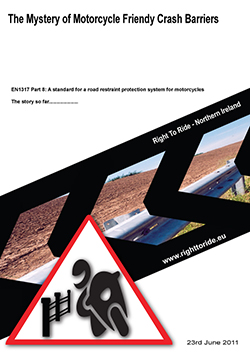Motorcycle Friendly Crash Barrier Standards – The Mystery of EN1317-8
 On Thursday, June 16, the CEN (European Committee for Standardization) technical committee on road equipment (TC226) held its annual meeting in Stockholm. The draft standard for a road restraint protection system for motorcycles (EN1317-8) was on the agenda.
On Thursday, June 16, the CEN (European Committee for Standardization) technical committee on road equipment (TC226) held its annual meeting in Stockholm. The draft standard for a road restraint protection system for motorcycles (EN1317-8) was on the agenda.
At the meeting, the committee chose to opt for a Technical Specification, which seems to have caused consternation amongst some motorcyclists. In fact the General Secretary of FEMA (Federation of European Motorcyclists Associations) commented “What will be done with this Technical Specification is a mystery to me. I have my doubts about the legitimacy of the arguments put forward by those who voted ‘no’ to a European Standard”.
Right To Ride contacted the CEN Committee secretary to find out the facts.
Over the previous months, representatives from various countries raised legitimate concerns about the Spanish protocol, because they felt that there were problems with the testing procedures for motorcyclists hitting crash barriers, the relevance of rider positions when crashing, the types of barriers and so forth. However the committee recognised that in the absence of something better, it was a starting point.
There was the general consensus within the Working Group 1 to develop the Spanish protocol and focus initially on the sliding configuration because the experience already gained with similar testing on a national basis would allow a European standard to be developed more quickly.
At the meeting on June 16th, rather than reject the proposed draft, the committee decided to accept it as a Technical Specification as an interim solution. Thus the committee did not vote “no” to a European Standard.
The convenor of CEN/TC 226/WG1 explained that the plan is to undertake inter-laboratory testing, to ensure that the test procedures are understandable and that when identical tests according to the protocol are performed by different laboratories in different countries, the results obtained are the same.
According to the CEN secretary, the TC226 committee expects to have this standard ready and approved within the next two/three years.
For a better understanding of the issues surrounding motorcycle friendly crash barriers, the involvement of riders’ organisations and the CEN TC226 Committee, read our paper:
“The Mystery of Motorcycle Friendly Crash Barriers” pdf 696kb – Click Here
Federation of European Motorcyclists Associations – CEN misses historic opportunity to adopt European guardrail standard for motorcyclists – Click Here


We have been in touch with the Italian rider’s organisation Motociclisti-Incolumi AMI and apart from their own report which correctly observed that the CEN vote was a step ahead of the current situation, they have carried our reported on their website.
Their comments to this are: “This explains the reasons for the TS (Technical Specification) and not as a publication as EN.
No rejection and, as usual, is not a problem of obstruction by the usual lobby of vested interests, big brother and so on, but simply the standard was not yet ready for approval as an EN. A perfectly reasonable position.
Now it’s up to us to push the agencies and road managers to really begin to take into account the new TS.”
Translated via Google Translate – Click Here
However “Motorcycle Friendly Barrier” systems in the UK have already passed a national standard for motorcyclist protection which does not affect the “operation” of the original barrier. These are in use in Great Britain but not in Northern Ireland.The DOE in its recently published Road Safety Strategy said they would, “Consider provision of specific route treatments for popular motorcycle ‘runs’ such as motorcycle ‘friendly’ barriers and additional signage.
Bikeguard – April 2009 pdf 3.7mb
Biker Safe – Energy Absorbent External Website
Flexguard pdf 1.1mb
Biker Mate – Crash Cushion for Roadside Objects External Website
Good question Ernest but hard to answer – however here is what a CEN Technical Specification is, which was adopted by CEN this may or may not be used for crash barriers, including Spain.
Technical Specifications (TS)
A Technical Specification (TS) is a normative document produced and approved by a Technical Committee.
A CEN/TS can be developed by CEN Technical Committees as a pre-standard which contains technical requirements for innovative technology, or when various alternatives need to coexist in anticipation of future harmonization that would not gather enough as to allow agreement on a European Standard (EN).
A TS does not have the status of an EN but may be adopted as national standard. Moreover there is no standstill, no public enquiry and no weighted vote.
A TS must be produced in one of the official CEN languages and its maximum lifetime is reduced to two or three years. A TS may not conflict with an EN. If a conflicting EN is subsequently published, the TS must be withdrawn.
http://www.cen.eu/cen/Products/TS/Pages/default.aspx
That’s the long answer. The short answer is that the proposed EN1317-8 is an additional system to an existing barrier. In the case of Spain, they have tested and created their own standard (which is the basis of the proposed EN1317-8). Having the standard, doesn’t mean that they have adopted it on all their roads. Just go on a trip around Spain and see how many roads are using “motorcycle friendly crash barriers”.
I’m curious. Spain is supposed to have this all singing, all dancing standard which saves lives – and that’s a good thing.
I just wonder on how many roads in Spain, these “motorcycle friendly crash barriers” are actually used?